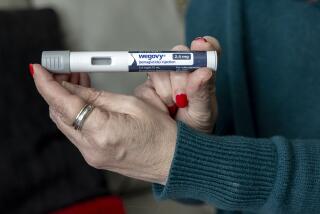Generic drugs are just as good
Stories like The Times’ ”Generics: Just as good?” are a disservice to Americans trying to make the best healthcare decisions for themselves and their families.
There is a reason that nearly two-thirds of prescriptions dispensed in the United States are filled with generic medicines. And that reason is simple: Doctors and pharmacists know that generics provide the same medicines as the brands with the same results, but their prices are much more affordable for patients. Millions of Americans have been benefiting from generic medicines for nearly 25 years.
Let’s look at the facts and put choice in the hands of consumers. By law, a generic medicine must meet the same high standards as its brand counterpart to receive approval from the Food and Drug Administration. This means that the FDA must ensure that the generic and the brand have the same amount of active ingredient at the same strength, as well as the same dosage form, labeling and use. Generics must also follow the same high-quality manufacturing standards as the brands.
An active pharmaceutical ingredient is what makes a drug work in the body. Inactive ingredients, also known as excipients, are things such as colors, flavors and binders. Because the size or color of a pill may be trademarked, the FDA allows different manufacturers to use different excipients. However, all inactive ingredients used in generic drugs must have been previously approved by the FDA. Companies that make generics often obtain their active and inactive ingredients from the very same suppliers as the brand companies. The ingredients also are checked for impurities and other quality attributes, and they must conform to FDA or U.S. Pharmacopeia standards.
To gain FDA approval, generic manufacturers also must prove that their medicines are bioequivalent, which means that the generic drug has the same effect in the body as the brand-name drug. As the FDA explains on its website: “Since the safety and efficacy of the brand-name product has already been well established in clinical testing and frequently many years of patient use, it is scientifically unnecessary, and would be unethical, to require that such extensive testing be repeated in human subjects for each generic drug that a firm wishes to market. Instead, generic applicants must scientifically demonstrate that their product is bioequivalent ... to the pioneer [brand] drug.”
Bioequivalence studies are conducted with human volunteers. In these studies, generic and brand drugs are administered, and blood or plasma levels of the drug are measured over time. The generic version must deliver the same amount of active ingredients into a patient’s bloodstream in the same amount of time as the brand drug. Based on these comparisons, the FDA can determine if the brand and generic products are equivalent. The FDA also applies statistical measures to further assure the accuracy of the data.
One statistical measure that is often misunderstood is the 80% to 125% statistical confidence interval. This does not mean that a generic product can differ by potency, level in the bloodstream, or amount of active ingredient by as much as 20% less or as much as 25% more from the brand drug. Rather, these statistical criteria assure that there is no significant difference in the patient’s blood level between the brand and generic product.
In fact, according to the American Medical Assn., “[T]he FDA has investigated numerous reports of potential generic product inequivalence, and the Agency has claimed it cannot document a single example of therapeutic failure when an FDA-designated therapeutically equivalent product was substituted for its reference (brand-name innovator) product.... [I]t is important to emphasize that when the formulation of a brand-name innovator drug product is changed by its manufacturer, not an infrequent occurrence, the identical bioequivalence tests are performed to show therapeutic equivalence.”
The FDA also has in place robust, high-quality, product-specific standards that must be adhered to for each batch of product as well as rigorous standards, known as good manufacturing practices, for facilities that manufacture and supply prescription drugs and their active ingredients. The highly regulated generic industry uses extensive, mandatory quality-control practices, has demonstrated its commitment to adhering to the highest quality standards for prescription drugs in the world and has a strong record of compliance.
Once a drug is on the market, generic manufacturers are further required to assure the safety of their products through post-marketing surveillance and reporting. Generic manufacturers must file quarterly adverse drug experience reports for the first three years after their product has been approved, and annually thereafter. In addition, serious and unexpected events must be reported to the FDA within 15 days.
Consumers should be assured that generic medicines contain the same medicine as the brands and provide patients with the same clinical effect. That’s our responsibility and the responsibility of the FDA. Ours is a complex, highly regulated industry with dedicated scientists who work hard to develop and safe and effective, high-quality medicines that meet the FDA’s rigorous standards. The public deserves nothing less.
Kathleen Jaeger is the president and chief executive of the Generic Pharmaceutical Assn. She was quoted in The Times’ story mentioned above.
More to Read
A cure for the common opinion
Get thought-provoking perspectives with our weekly newsletter.
You may occasionally receive promotional content from the Los Angeles Times.










